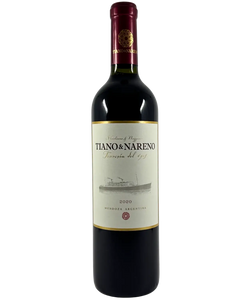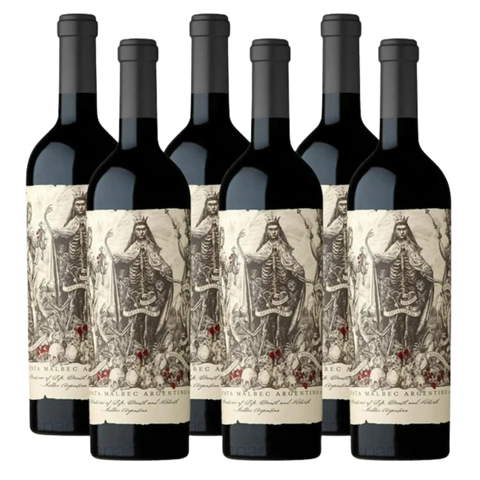Argentina may be famous for its steak and tango, but when it comes to wine, Malbec reigns supreme. And while plenty of bottles are made for early drinking, a handful of producers are crafting wines at the very top tier of global collectability. One of the rarest? Tiano & Nareno’s Travesía 1908.
With fewer than 6,000 bottles produced per vintage — and only released in exceptional years — this is one of Argentina and South America’s most exclusive wines. Here’s what makes it so remarkable.
Argentina’s unique wine landscape
Argentina sits close to the equator — a latitude normally too hot for fine winegrowing. The secret lies in altitude. Most vineyards are planted high in the Andes foothills, where cooler nights slow ripening, helping grapes retain acidity while sugars climb more gradually.


Caption: Map of Argentina. Source: Wine Spirit Education Trust
In the sub-region of Luján de Cuyo, where Tiano & Nareno is based, vineyards sit 900–1,100 metres above sea level. Beyond elevation, cold air spilling down from the Andes adds another natural cooling influence, giving the wines elegance and balance.
How Argentina protects its fruit from the sun
Heat management is critical here. Historically, vines were trained on pergolas — overhead structures that shaded grapes from intense sunlight and kept them from hanging close to the heat-retaining soil. Today, trellising systems achieve the same goal, reducing the risk of sunburn.
It’s a challenge shared by other hot-climate regions. In the Hunter Valley, for example, you’ll sometimes see grapes literally sprayed with sunscreen during peak summer — a reminder of how creative viticulture gets when battling heat.


Caption: Vines in the Hunter Valley with sunscreen. Source: Wine Australia
Making wine in the desert
Argentina’s vineyards are mostly inland, cut off from ocean breezes by the Andes. This means a desert climate: hot days, little rain, and vineyards surviving thanks to irrigation from mountain meltwater and underground oases of water.
Traditionally, this meant flood irrigation — trenches dug between rows and filled with water. Today, most producers use drip irrigation, providing precision water management and ensuring vines focus on quality over quantity.


Caption: Examples of flood & drip irrigation in Argentina. Source: Wine Spirit Education Trust
Malbec: from Bordeaux to Mendoza
Malbec may be Argentina’s signature grape, but it didn’t start here. It originated in Bordeaux, where it was traditionally used in blends. Argentina now produces the majority of the world’s Malbec, but the Bordeaux heritage remains: many Argentine blends still include Cabernet Sauvignon and Cabernet Franc alongside Malbec.
In Central Mendoza, Malbec tends to show its most elegant expression — more restrained, perfumed, and structured than in hotter, lower-altitude regions.
The story of Tiano & Nareno
Tiano & Nareno traces its roots back to 1908, when Italian immigrants Sebastiano and Nazzareno began cultivating Malbec in Argentina. A century later, their grandson revived the label to honour that heritage, collaborating with none other than the President of Champagne Salon and Delamotte.
Like Salon, Tiano is only made in exceptional years. In the past 20 years, there have been just seven vintages released — placing it firmly in the top 1% of the wine world alongside icons like Dom Pérignon and Château d’Yquem.
And with under 6,000 bottles released per vintage, it’s also one of the rarest wines in South America.
The 2020 vintage: tasting notes
The 2020 Travesía 1908 is a wine that stops you in your tracks. Deep purple in colour, it signals youth and vitality (most wines brown with age — Malbec’s vibrant hue is unmistakable).
- Black fruit carries through, layered with spice and a slight candied note
- Fine, powdery tannins with a gripping freshness from high acidity
- French oak adds spice, structure, and complexity via controlled oxygen contact
- Hints of herbaceous lift, suggesting whole bunch fermentation — a technique increasingly explored with Malbec in Argentina
Despite its balance, the 2020 is very young. Alcohol is high but well integrated, and the wine shows the structure to age for 20+ years. The small Cabernet Franc component brings softness, which will reveal itself more with time.
Why it’s considered collectible
Tiano & Nareno isn’t just rare — it’s incredibly scarce, highly selective, and critically acclaimed.
- Scarcity: fewer than 6,000 bottles per vintage, only released in exceptional years
- Auction potential: while Malbec is less established than Burgundy or Bordeaux at auction, top Argentine wines (like Catena Zapata’s Nicolás Catena Zapata and Cheval des Andes) have increasingly sold well, proving the global market is paying attention
- Collector credibility: in serious circles, Tiano is considered one of Argentina’s finest. It’s a true IYKYK (If You Know You Know) wine — and those often become the ones that grow most in demand over time
TradingGrapes may be the only retailer in Australia with access to the 2020 vintage — a testament to just how limited supply really is.
Why it belongs in a serious cellar
The 2020 Tiano & Nareno Travesía 1908 is more than a bottle of Malbec. It’s a piece of Argentina’s viticultural story, a collaboration that bridges heritage and modern prestige, and a wine that belongs in any serious cellar.
With fruit, spice, finesse, and the power to age decades, it’s both a joy to drink and an asset worth holding.
For collectors and drinkers alike, this is Argentina at its most refined.
Need help sourcing the top 1% of the wine market?
We stock a limited amount of investment grade wines and have access to plenty more from Salon to Screaming Eagle. If you're after something specific (or more of a favourite)? Let us know - we love sourcing more wine🍷
Important
Please know, the information on our website is general in nature, we don’t provide advice and individuals should make their own decisions. The value of investments can go up as well as down and you may receive back less than your original investment. Further, the tax on your investments depends on your individual circumstances and may be subject to change.






